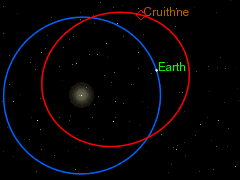Quasi-satellite

A quasi-satellite is an object in a specific type of co-orbital configuration (1:1 orbital resonance) with a planet where the object stays close to that planet over many orbital periods.
A quasi-satellite's orbit around the Sun takes exactly the same time as the planet's, but has a different eccentricity (usually greater), as shown in the diagram on the right. When viewed from the perspective of the planet, the quasi-satellite will appear to travel in an oblong retrograde loop around the planet.
In contrast to true satellites, quasi-satellite orbits lie outside the planet's Hill sphere, and are unstable. Over time they tend to evolve to other types of resonant motion, where they no longer remain in the planet's neighbourhood, then possibly later move back to a quasi-satellite orbit, etc.
Other types of orbit in a 1:1 resonance with the planet include horseshoe orbits and tadpole orbits around the Lagrangian points, but objects in these orbits do not stay near the planet's longitude over many revolutions about the star. Objects in horseshoe orbits are known to sometimes periodically transfer to a relatively short-lived quasi-satellite orbit,[1] and are sometimes confused with them. An example of such an object is 2002 AA29.
Examples

- Earth
As of 2014, Earth has several known quasi-satellites: (164207) 2004 GU9,[2] (277810) 2006 FV35,[3] and 2014 OL339.[4]
3753 Cruithne,[5] 2002 AA29,[1] and 2003 YN107 are minor planets in a horseshoe orbit that can transition into a quasi-satellite orbit. 2003 YN107 was in a quasi-satellite orbit from 1996 to 2006.
- Venus
Venus has a quasi-satellite, 2002 VE68. This asteroid is also a Mercury- and Earth-crosser; it seems to have been a "companion" to Venus for the last 7000 years or so only, and is destined to be ejected from this orbital arrangement about 500 years from now.[6]
- Neptune
(309239) 2007 RW10 is a temporary quasi-satellite of Neptune.[7] The object has been a quasi-satellite of Neptune for about 12,500 years and it will remain in that dynamical state for another 12,500 years.[7]
- Other planets
Based on simulations it is believed that Uranus and Neptune could potentially hold quasi-satellites for the age of the Solar System (about 4.5 billion years),[8] but a quasi-satellite's orbit would remain stable for only 10 million years near Jupiter and 100,000 years near Saturn. Jupiter and Saturn are known to have quasi-satellites.[9]
- Artificial
In early 1989, the Soviet Phobos 2 spacecraft was injected into a quasi-satellite orbit around the Martian moon Phobos, with a mean orbital radius of about 100 kilometres (62 mi) from Phobos.[10] According to computations, it could have then stayed trapped in the vicinity of Phobos for many months. The spacecraft was lost due to a malfunction of the on-board control system.
- Accidental
Some objects are known to be accidental quasi-satellites, which means that they are not forced into the configuration by the gravitational influence of the body of which they are quasi-satellites.[9] The minor planets Ceres, Vesta, and Pluto are known to have accidental quasi-satellites.[9] In the case of Pluto, the known accidental quasi-satellite, (15810) 1994 JR1, is, like Pluto, a plutino, and is forced into this configuration by the gravitational influence of Neptune.[9] This dynamical behavior is recurrent, the object becomes a quasi-satellite of Pluto every 2 Myr and remains in that configuration for nearly 350,000 years.[9][11]
See also
References
- ↑ 1.0 1.1 Connors, Martin; Chodas, Paul; Mikkola, Seppo; Wiegert, Paul; Veillet, Christian; Innanen, Kimmo (2002). "Discovery of an asteroid and quasi-satellite in an Earth-like horseshoe orbit". Meteoritics & Planetary Science 37 (10): 1435–1441. Bibcode:2002M&PS...37.1435C. doi:10.1111/j.1945-5100.2002.tb01039.x.
- ↑ Brasser, R. et al. (September 2004). "Transient co-orbital asteroids". Icarus 171 (1): 102–109. Bibcode:2004Icar..171..102B. doi:10.1016/j.icarus.2004.04.019.
- ↑ "Dynamical evolution of Earth’s quasi-satellites: 2004 GU9 and 2006 FV35". Icarus 209 (2): 488–493. October 2010. Bibcode:2010Icar..209..488W. doi:10.1016/j.icarus.2010.05.012.
- ↑ de la Fuente Marcos, C.; de la Fuente Marcos, R. "Asteroid 2014 OL339: yet another Earth quasi-satellite". Monthly Notices of the Royal Astronomical Society. arXiv:1409.5588. Bibcode:2014arXiv1409.5588D.
- ↑ Christou, Apostolos A.; Asher, David J. (2011). "A long-lived horseshoe companion to the Earth". Monthly Notices of the Royal Astronomical Society 414 (4): 2965–2969. arXiv:1104.0036. Bibcode:2011MNRAS.414.2965C. doi:10.1111/j.1365-2966.2011.18595.x.
- ↑ Mikkola, S.; Brasser, R.; Wiegert, P.; Innanen, K. "Asteroid 2002 VE68, a quasi-satellite of Venus". Monthly Notices of the Royal Astronomical Society 351 (3): L63–L65. Bibcode:2004MNRAS.351L..63M. doi:10.1111/j.1365-2966.2004.07994.x.
- ↑ 7.0 7.1 de la Fuente Marcos, C.; de la Fuente Marcos, R. (September 2012). "(309239) 2007 RW10: a large temporary quasi-satellite of Neptune". Astronomy and Astrophysics Letters 545: L9. arXiv:1209.1577. Bibcode:2012A&A...545L...9D. doi:10.1051/0004-6361/201219931.
- ↑ Wiegert, P.; Innanen, K. (2000). "The stability of quasi satellites in the outer solar system". The Astronomical Journal 119 (4): 1978–1984. Bibcode:2000AJ....119.1978W. doi:10.1086/301291.
- ↑ 9.0 9.1 9.2 9.3 9.4 de la Fuente Marcos, C.; de la Fuente Marcos, R. (2012). "Plutino 15810 (1994 JR1), an accidental quasi-satellite of Pluto". Monthly Notices of the Royal Astronomical Society: Letters. arXiv:1209.3116. Bibcode:2012MNRAS.427L..85D. doi:10.1111/j.1745-3933.2012.01350.x.
- ↑ Green, LM; Zakharov, AV; Pichkhadze, KM. Что мы ищем на Фобосе [What we are looking for [on] Phobos] (in Russian). Archived from the original on 2009-07-20.
- ↑ "Pluto's fake moon". Retrieved 2012-09-24.
External links
| Look up quasisatellite in Wiktionary, the free dictionary. |